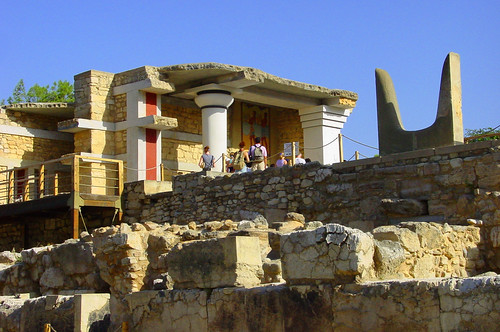
With 17,000 square meters and over 1,500 rooms, the palace of Knossos (Cnosos or) was the main construction Minoan palace of culture, home of the legendary King Minos, and according to Greek mythology, also of the Minotaur, the half man and be fantastic half bull for which the king ordered the construction of the mythical labyrinth.
The Minoan civilization was developed in the island of Crete in the period prehelénico and saw the beautiful buildings of palaces, of which we know a good number, Knossos is one of the most important and best known through the excavations conducted by Arthur Evans in the early twentieth century.
The Palace of Knossos was built around 2000 BC and destroyed by an earthquake three centuries later, although it was rebuilt in the following years. Continued to experience multiple destruction, was abandoned and then reclaimed by the Doria and Romans. In its glory housed over a thousand sculptures and impressive mural paintings, had sewage systems, water and even paved roads. It is believed that it lived some three hundred people, including the royal family and their servants, and that was raised to five plants.
Although not enough words to describe the beauty of this ancient and fascinating building monumental that it causes can be emphasized certain precincts of the palace, as the Great Hall of the Throne, where stands the throne in the alabaster ever had to sit on Minos himself, with a stunning mural. Or the Queen’s Megaron, which houses the famous fresco of dolphins.
The mural stands out around the palace, both the representations of women as animals, plants, and not so everyday activities, such as «bull jumping» or bullfighting Cretan sport feared and loved by the Minoan. Also in the portico frescoes representing various scenes from the bulls that survived the massive head of a bull red, visible throughout antiquity and most likely responsible for the association of the Minotaur myth of the great palace.

Palace of Knossos
Hours: Open daily from 08.00 to 18.00
Price: 6 €. Free for children under 18 years, a student of Greek or EU
You can also save money if you’re one of these days:
Sunday between November 1 and March 31.
The first Sunday of each month except July, August and September. If you fall on a Sunday that would move the party to supply and so on.
On March 6 Memorial Melina Mercouri.
April 18, International Day of the monuments.
May 18, International Museum Day.
June 5, on international environmental governance.
The last week of September, the European Heritage Days.
There is the possibility of a common ticket for the palace and the museum for 10 €.
How to get there?
From Herakleion, the capital of the island of Crete, the palace is located about 5 km. You can take bus line number 2 and takes about 20 minutes.

Leave a Reply
You must be logged in to post a comment.
Recent Comments